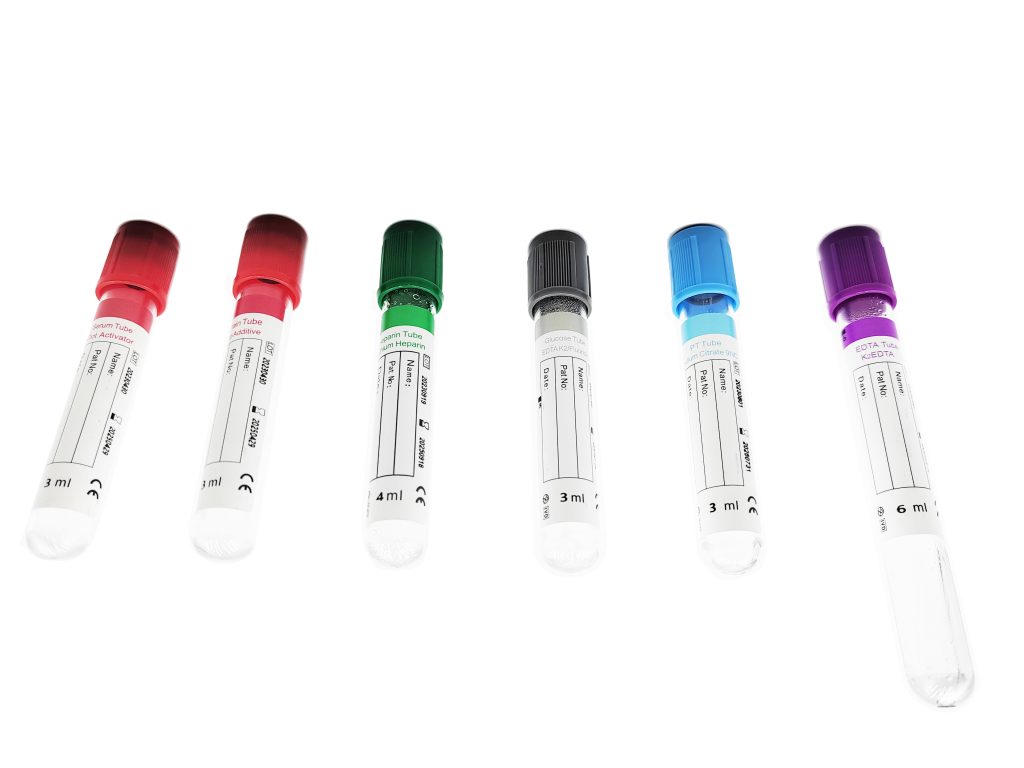Vacuum blood collection tube uses

Blood collection tubes are distinguished by the color of their caps.
- Ordinary serum tubes have red caps. The blood collection tubes do not contain additives and are used for routine serum biochemistry, blood bank and serology related tests.
- The rapid serum tube has a red cap, and there is a coagulant in the blood collection tube to accelerate the coagulation process. The rapid serum tube can coagulate the collected blood within 8 minutes and is suitable for emergency serum serial testing.
3.The separation gel accelerating coagulation tube has a yellow head cover, and the separation gel and coagulation accelerator are added to the blood collection tube. After the specimen is centrifuged, the separating gel can completely separate the liquid components (serum or plasma) and solid components (red blood cells, white blood cells, platelets, fibrin, etc.) in the blood and completely accumulate them in the center of the test tube to form a barrier. The specimen is maintained within 48 hours. Stablize. Procoagulants can quickly activate the coagulation mechanism and accelerate the coagulation process, and are suitable for emergency serum biochemical tests.
- Heparin anticoagulation tubes have green caps and heparin is added to the blood collection tubes. Heparin directly acts as an antithrombin and can prolong the coagulation time of specimens. It is suitable for red blood cell fragility test, blood gas analysis, hematocrit test, erythrocyte sedimentation rate and universal biochemical determination. It is not suitable for hemagglutination test. Excessive heparin can cause aggregation of white blood cells and cannot be used for white blood cell counting.
- EDTA anticoagulant tube has a purple cap. Ethylenediaminetetraacetic acid (EDTA, molecular weight 292) and its salts are an aminopolycarboxylic acid that can effectively chelate calcium ions in blood specimens, chelate calcium or react calcium Removal of the site will block and terminate the intrinsic or extrinsic coagulation process, thereby preventing the blood sample from coagulating. Suitable for general hematology tests, not suitable for coagulation tests and platelet function tests, nor suitable for determination of calcium ions, potassium ions, sodium ions, iron ions, alkaline phosphatase, creatine kinase and leucine aminopeptidase , suitable for PCR testing.
- The sodium citrate coagulation test tube has a blue cap. Sodium citrate mainly acts as an anticoagulant by chelating calcium ions in the blood sample. Suitable for coagulation experiments, the anticoagulant concentration recommended by the National Committee for Clinical Laboratory Standards (NCCLS) is 3.2% or 3.8% (equivalent to 0.109mol/L or 0.129mol/L). The ratio to blood is 1:9.
- Sodium citrate erythrocyte sedimentation test tube has a black cap. The sodium citrate concentration required for the erythrocyte sedimentation test is 3.8% (equivalent to 0.109 mol/L). The ratio of anticoagulant to blood is 1:4.
- Potassium oxalate/sodium fluoride gray cap. Sodium fluoride is a weak anticoagulant. It is usually used in combination with potassium oxalate or sodium etiodate. The ratio is 1 part sodium fluoride and 3 parts potassium oxalate. . 4 mg of this mixture can prevent 1 ml of blood from coagulating and inhibiting the decomposition of sugar within 23 days. It is a good preservative for blood glucose measurement. It cannot be used for the determination of urea by urease method, nor can it be used for the determination of alkaline phosphatase and amylase. Recommended for blood glucose testing.